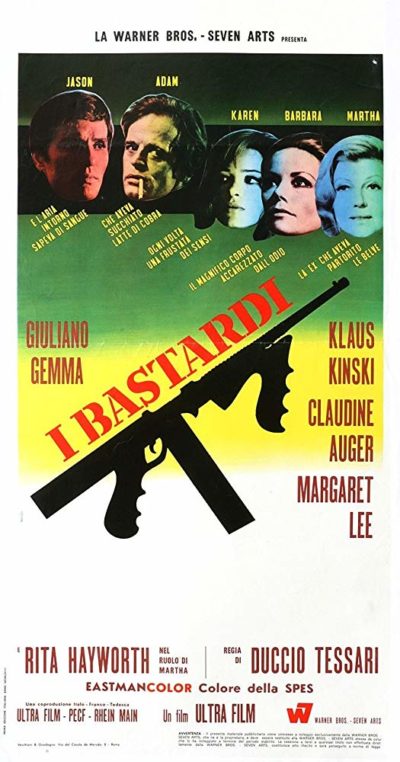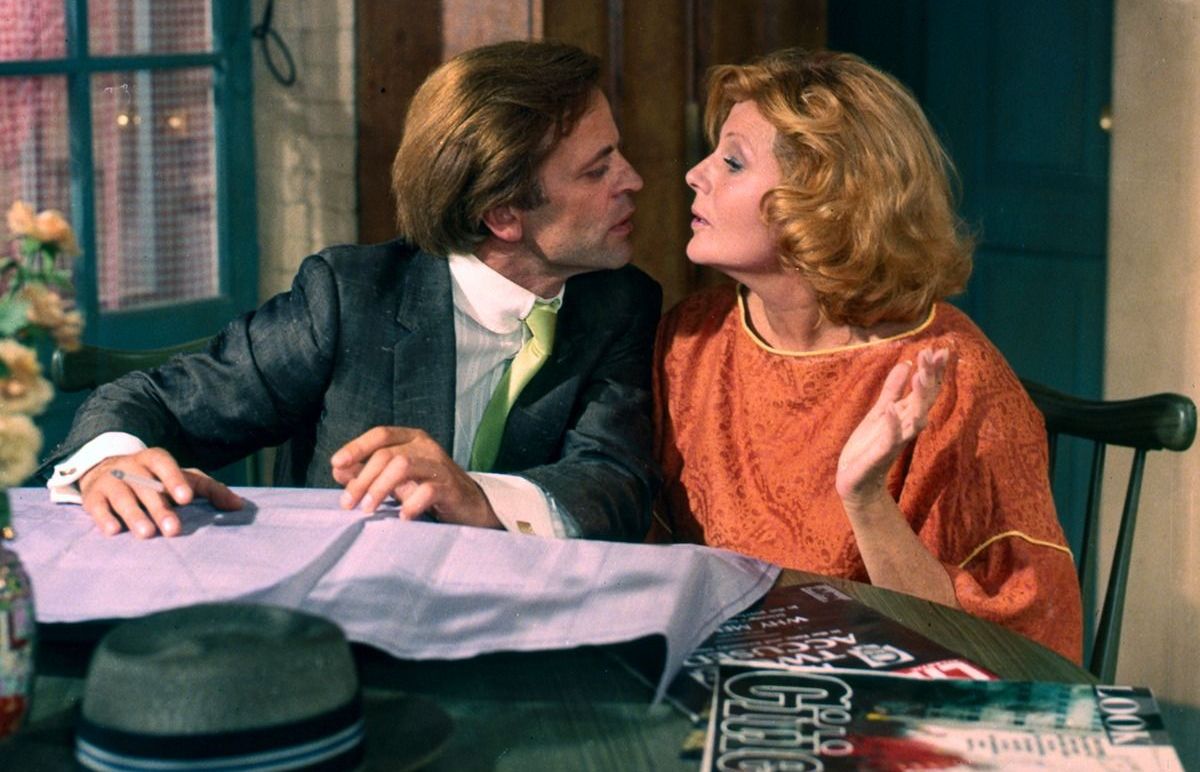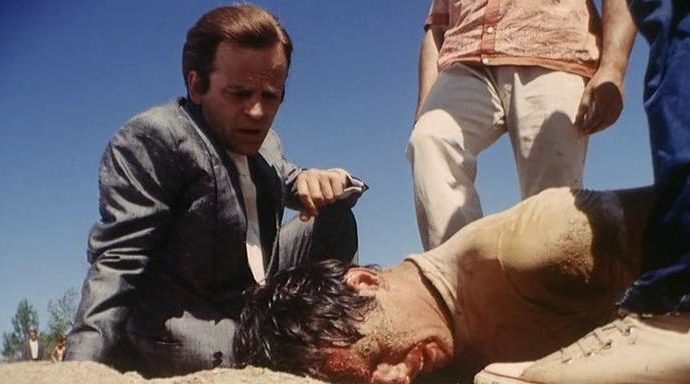Dir: Duccio Tessari
Star: Giuliano Gemma, Klaus Kinski, Margaret Lee, Rita Hayworth
a.k.a. I Bastardi, The Cats
This Italian production is supposedly set in Arizona, with references to Phoenix, Yuma, etc. though the illusion is on rather thin ice, given the large caption in the opening credits, thanking New Mexico for their assistance in making the film! Sadly, these false pretenses are something which still happen even now. Sicario also saw New Mexico stand in for Arizona, and in the third season of Queen of the South, the part of Arizona was played by the considerably more arboreal Texas. Even though thia was reportedly shot mostly in Spain, as an Arizona resident, such deception is not inclined to make me look kindly on the film, though it does have some positive aspects.
 It’s the story of two brothers, Jason (Gemma) and Adam (Kinski), career criminals. Jason carries out a jewel heist, and at Adam’s request, uses the loot as bait to lure in the family’s enemies, so they can be disposed of by Jason. This goes swimmingly, only for Adam to get greedy and also demand a share of the jewels, which Jason feels should be payment for his bloody work. Considering the number of dead bodies he had to go through to keep the ill-gotten gains, I can kinda see his argument. After he refuses to share, Adam goes after Jason and eventually gets him to give up the loot after threatening his girlfriend, Karen (Lee).
It’s the story of two brothers, Jason (Gemma) and Adam (Kinski), career criminals. Jason carries out a jewel heist, and at Adam’s request, uses the loot as bait to lure in the family’s enemies, so they can be disposed of by Jason. This goes swimmingly, only for Adam to get greedy and also demand a share of the jewels, which Jason feels should be payment for his bloody work. Considering the number of dead bodies he had to go through to keep the ill-gotten gains, I can kinda see his argument. After he refuses to share, Adam goes after Jason and eventually gets him to give up the loot after threatening his girlfriend, Karen (Lee).
To ensure there’s no retaliation, Adam gets his pet doctor to inject Jason’s gun-hand, damaging it, and abandons him in the desert. He’s rescued and brought to the ranch of Barbara (Claudine Auger), who nurses him back to health. Naturally, he learns to shoot with his other hand [If I ever become an evil overlord, I will avoid the “cripple my enemies but leave them alive” approach, since it always seems to come back to bite the bad guy in the end] After getting better, Jason heads back to take revenge on his brother – who, adding insult to literally injury, is shacked up with Karen. This leads to a final confrontation – this time really in New Mexico (yeah, I’m still bitter…), in which the earth literally and unexpectedly moves.
I could have sworn Kinski had worked with Tessari on a number of films, but it seems this was their only collaboration. Tessari was perhaps better known as a writer, having done some uncredited work on A Fistful of Dollars, but directed close to thirty films, mostly in the sixties and seventies. He had helped launch Gemma’s career in 1965, writing and directing the successful Spaghetti Western, A Pistol for Ringo. In many ways, it’s easy to see The Bastard as another entry in the same genre. Despite its contemporary setting – there is some frantic disco-dancing going on in an early scene – the story of brotherly betrayal and resulting retribution could just as easily have been set in the eighteen sixties as the nineteen sixties. [Sidenote: the frequently-heard theme song is called Love and Money. No apparent connection to the film of the same name Kinski would make in 1982]
Perhaps the most poignant character is screen icon Hayworth (coincidentally, the centennial of her birth was earlier this month), playing the alcoholic mother of the brothers, in a role apparently offered to and declined by Joan Crawford. It’s a case of art imitating life, given her long struggle with the bottle. Her role is key, as Mom’s cheerful chattiness, divulging Adam’s plans to rob an armored car to Jason, on his return from his recuperation, help open the door for Jason to take vengeance. Really, it’s only when Hayworth and/or Kinski are on-screen that this rises much above the humdrum. The difference in on-screen charisma and presence between them and Gemma, as well as the rest of the supporting cast, is painfully obvious. A friend who runs a film distribution company once said that it’s important for a movie to have all the performances at the same level – not necessarily good or bad, just equal. The Bastard certainly fails on that criteria.
It’s at its best in the early going, when Kinski and Hayworth are around the most. After the betrayal of Jason by his brother, both largely vanish from the middle section, and the film suffers significantly as a result. It doesn’t help that not much happens: you’re largely watching someone rehab from injury, which falls short in terms of entertainment value. The strange deus ex machina which occurs as a key element of the final section is straight-up bizarre, and left me wondering who, exactly, thought it was a good idea, and why. [Had they been in California, rather than New Mexico, it would have made more sense; as is, it shows a rather poor grasp of Southwestern geology]

There’s an anecdote about the film in Kinski Uncut (p.199), in which he details having a threesome with Margaret Lee (calling her Margareth) and a hairdresser, interrupted by the arrival of then-girlfriend Susanne Moratti. Oddly, that version omits a fact included in the original version of his biography, All You Need is Love; the apparently harmless point that Lee was the wife of his agent, Gina Malerba.
Margareth is friends with a hairstylist, whom she brings along to Madrid. I want to seduce the hairstylist, who’s such an inveterate lesbian that she smacks my hand whenever I feel up Margareth. I invite them to my suite at the Palace Hotel and dance with the hairstylist while Margareth jerks off on the bed. I’ve already got my finger inside the hairdresser’s little pussy – but then the doorbell rings. When I open the door, ready to yell at the party-pooper, I find Susanne, who hugs me passionately. She could have called or wired! I draw out our greeting in the vestibule as long as possible so that the two women inside can straighten up their clothes. Before introducing Susanne, I whisper to her: “They’re two dykes. They were about to leave.”
Beginning with Circus of Fear, Lee and Kinski worked together in eleven different movies, which has to be some kind of record. While she acknowledges his ferocious temper, she seems to remember him fondly: “What I saw was the extremely sensitive person, to whom early life had dealt cruel blows, that lay behind the difficult behaviour.” However, let the record show she completely denies Klaus’s story, saying “This is totally untrue and I am sorry he abased himself this way, and our friendship.”
